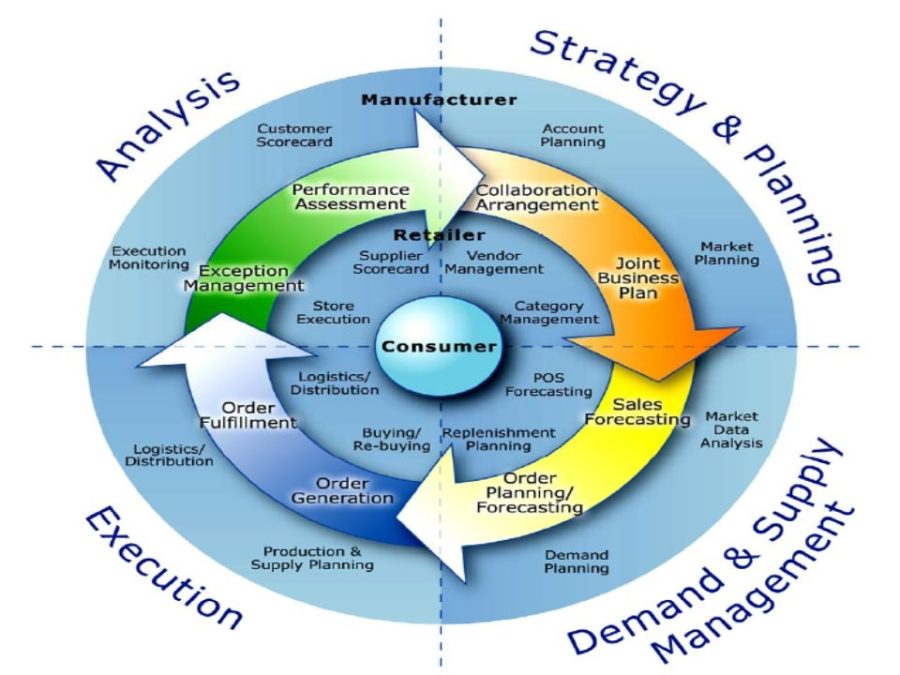Collaborative Planning, Forecasting and Replenishment (CPFR) is defined as a business practice that combines the brainpower of two or more trading partners in planning the ways to fulfill the customer demand. They also explained the relationship that CPFR links best practices of sales and marketing, such as category management, to the implementation of supply chain planning and completion process, to increase availability while reducing inventory, transportation and logistics costs. Basically CPFR is an approach that deals with the requirements for good demand management. The most involved industries with CPFR are consumer products and food and beverage. The main objective of Collaborative Planning, Forecasting and Replenishment (CPFR) is to “optimize” the supply chain process by: Improving accuracy of forecasting demand, Delivering the right product at the right time to the right location, Reducing inventory, Avoiding stock outs, and Improving customer service. But the most important fact on which the achievement of Continue reading
Operations Management Concepts
Seven Management and Planning Tools
Competition level within every industry is constantly growing and businesses try to find any possible ways to improve quality of products and services. However, quality is quite a complex concept that can be viewed as a measure of perfection. Quality improvement leads to a perfect product that is meant to satisfy the customer. In the early 1980s, the seven management and planning tools were designed as major tools for effective planning and management of processes, which are above the quality operation. They are as follows: 1. Affinity Diagrams The first of the tools in the list is Affinity diagrams. The affinity diagram is a visual brainstorming instrument that can be used to categorize various facts and data, ideas and opinions by a proximity factor. It is especially useful for the purpose of systematization of big data into groups and categories, according to some forms of affinity. In its own turn, Continue reading
Case Study: Quality Management System at Coca Cola Company
Coca Cola’s history can be traced back to a man called Asa Candler, who bought a specific formula from a pharmacist named Smith Pemberton. Two years later, Asa founded his business and started production of soft drinks based on the formula he had bought. From then, the company grew to become the biggest producers of soft drinks with more than five hundred brands sold and consumed in more than two hundred nations worldwide. Although the company is said to be the biggest bottler of soft drinks, they do not bottle much. Instead, Coca Cola Company manufactures a syrup concentrate, which is bought by bottlers all over the world. This distribution system ensures the soft drink is bottled by these smaller firms according to the company’s standards and guidelines. Although this franchised method of distribution is the primary method of distribution, the mother company has a key bottler in America, Coca Continue reading
Quality Control (QC) – Meaning, Definition, and Benefits
What is Quality? Quality has become one of the most important factors of consumers decision in selecting a product among competing products (services). This phenomenon is wide spread regardless of the fact whether the consumer is an individual organisation, retail store, or a military defense programme. The quality of products / services can be evaluated in several ways. It is important to identify different dimensions of quality Garrin (1987) discusses eight components or dimensions of quality as follows. Performance (Will the product do intended job?) Reliability (How often does the product fail?) Durability (How long does the product last?) Serviceability (How easy is it to repair the products?) Aesthetics (How the product looks like?) Features (What does the product do?) Perceived Quality (What is the reputation of the company?) Conformance to standards (Is the product made exactly as the design indented?) Meaning of Quality Control Quality control is defined as Continue reading
Just-In-Time (JIT) Method – Eliminate Waste and Improve Productivity
Just-in-time or JIT means producing goods and services exactly when they are needed, like for example a new company opens that is producing steering shaft for automobiles. The company, under the JIT system, will set up the machines to produce the jobs in a row from those who collect the metals at one end, all of the way to those who ship the product at the other end of the factory. The people at each station, as they receive the product, take the job order, perform their duties on the product, and then transfer the product out to the next station after their work is completed. Along the way, the product is screened for infirmities, and if they exist, the line is stopped until the defect is repaired. In the end, the shipping agent will receive the product and ship it to the customer. All along Continue reading
5S – Japanese Concept of Workplace Improvement
What is 5S Concept? Simply put, 5S is a method/Japanese concept for organizing a workplace, especially a shared workplace (like a shop floor or an office space). It’s sometimes referred to as a housekeeping methodology, however this characterization can be misleading because organizing a workplace goes beyond housekeeping (see discussion of “Seiton” below). The key targets of 5S concept are workplace morale and efficiency. The assertion of 5S is, by assigning everything a location, time is not wasted by looking for things. Additionally, it is quickly obvious when something is missing from its designated location. 5S advocates believe the benefits of this methodology come from deciding what should be kept, where it should be kept, and how it should be stored. This decision making process should lead to a dialog which can build a clear understanding, between employees, of how work should be done. It also instills ownership of the Continue reading



